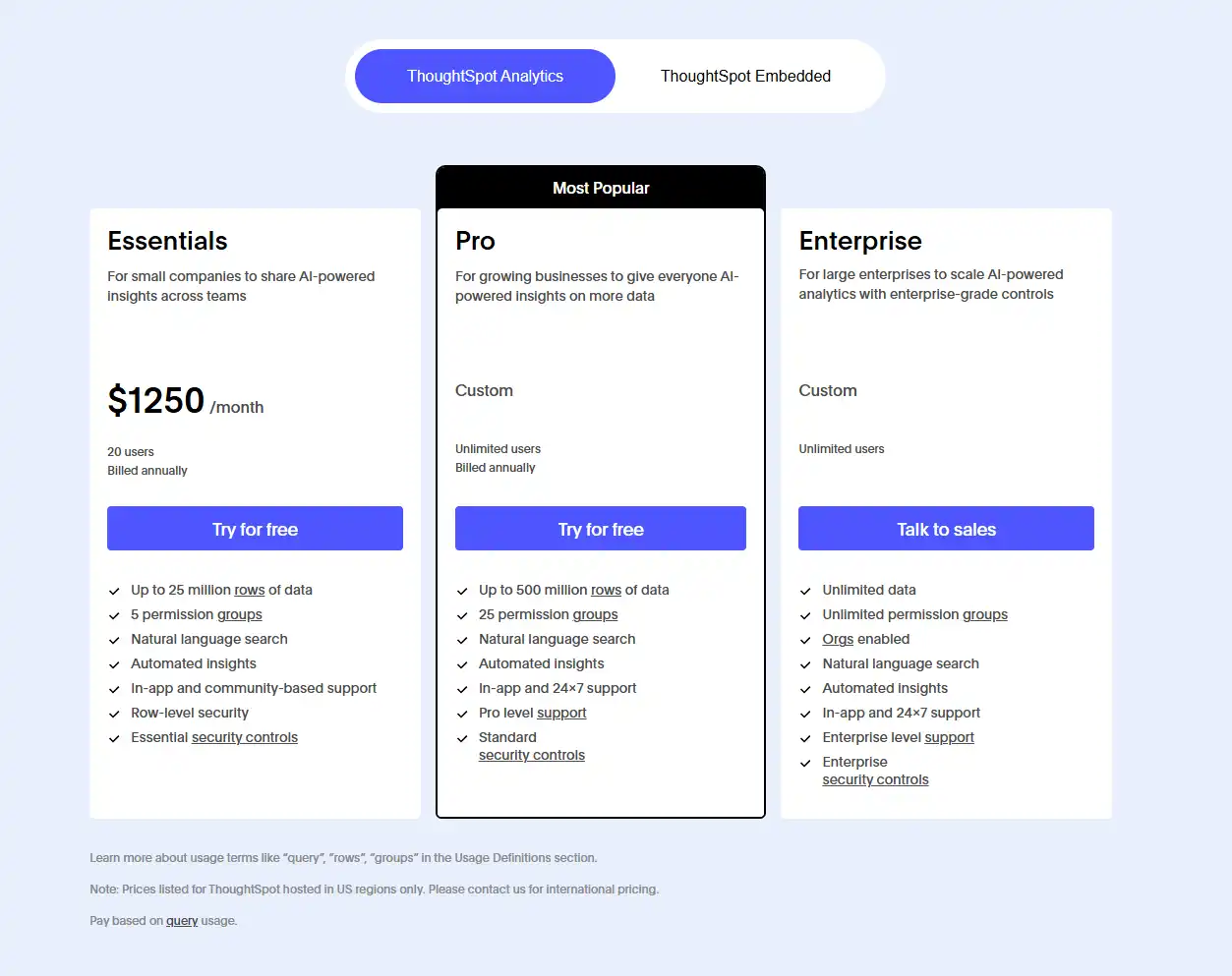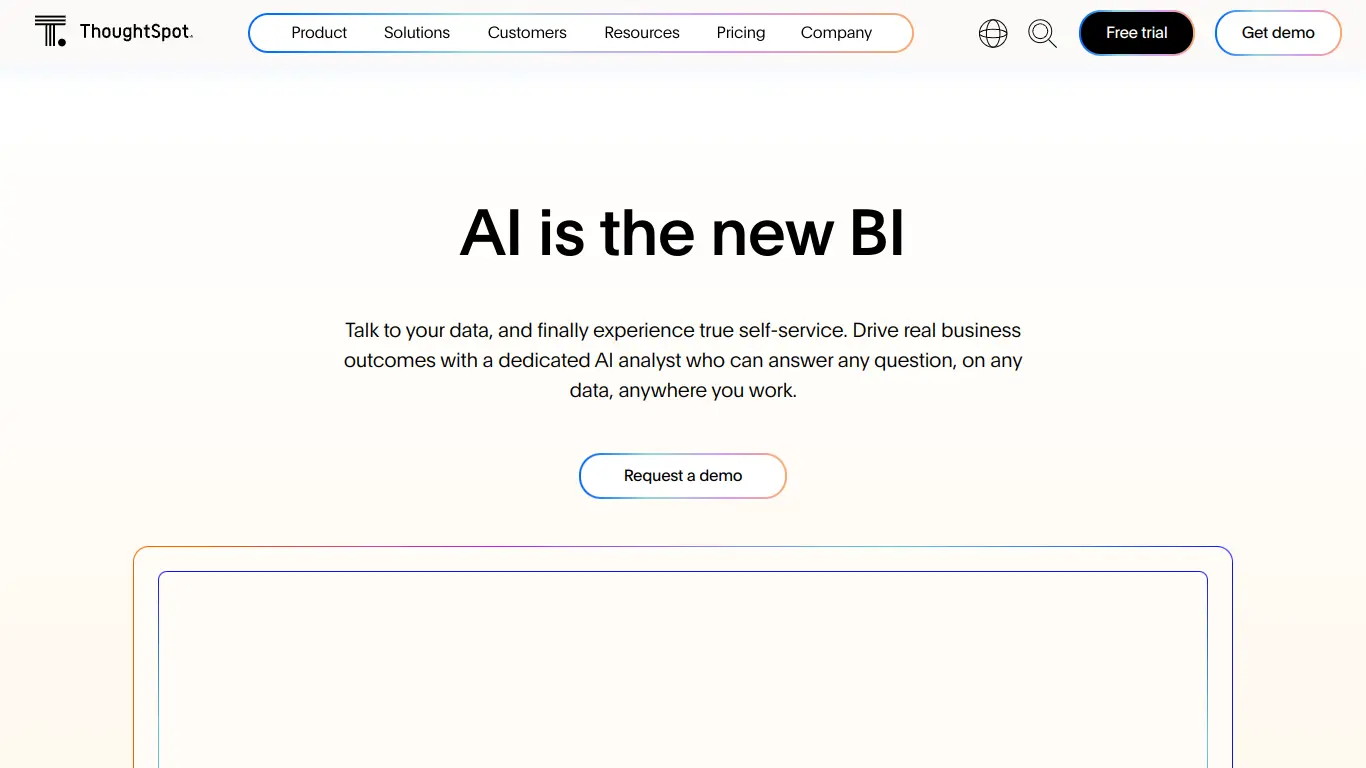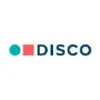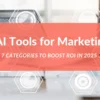ThoughtSpot is an AI-driven analytics platform that democratizes data through search-based insights for enterprises of all sizes.
Introduction to ThoughtSpot
Organizations are drowning in information but starving for insights. The traditional business intelligence tools often create bottlenecks where data analysis becomes the domain of specialists, leaving business users waiting in line for answers. This is where ThoughtSpot enters the picture, revolutionizing how companies interact with their data.
What is ThoughtSpot and its Purpose?
ThoughtSpot is a modern business intelligence and data analytics platform that uses artificial intelligence and machine learning to provide insights from company data. Unlike traditional BI tools that require technical expertise, ThoughtSpot was built with a simple mission: to make data accessible to everyone through a Google-like search interface.
At its core, ThoughtSpot aims to democratize data analytics by enabling business users to ask questions of their data using natural language and receive instant, actionable insights. The platform combines search and AI technologies to understand user intent and generate relevant visualizations and insights automatically.
ThoughtSpot’s purpose is straightforward yet powerful: eliminate the barriers between people and data. By providing a self-service analytics platform, it bridges the gap between technical data teams and business users, allowing everyone to make data-driven decisions without depending on data analysts or IT teams.
Who is ThoughtSpot Designed For?
ThoughtSpot caters to a wide range of users across organizations:
- Business Users: Employees who need data insights but lack technical skills can easily search for answers using familiar language.
- Data Analysts: Professional analysts can create more sophisticated models and data connections while spending less time on routine report creation.
- IT Departments: IT teams can maintain governance while reducing the report backlog that typically bogs down their productivity.
- Executives: Leaders can access real-time insights for strategic decision-making without waiting for reports to be prepared.
ThoughtSpot is particularly valuable for enterprises with large volumes of data spread across multiple sources. Industries that have embraced ThoughtSpot include retail, financial services, healthcare, manufacturing, and technology companies looking to become more data-driven in their operations.
Getting Started with ThoughtSpot: How to Use It
Starting with ThoughtSpot is surprisingly straightforward, especially given the sophisticated technology under the hood:
- Connection to Data Sources: First, ThoughtSpot connects to your existing data sources, whether they’re cloud data warehouses like Snowflake, Amazon Redshift, and Google BigQuery, or SaaS applications like Salesforce and ServiceNow.
- Search-Based Interface: Once data is connected, users can type natural language queries into the search bar. For example, typing “sales by region last quarter” will automatically generate the appropriate visualization.
- SpotIQ AI Analysis: ThoughtSpot’s AI engine, SpotIQ, can automatically analyze billions of data points to find hidden insights, anomalies, and trends that might otherwise go unnoticed.
- Pinboards and Sharing: Users can save and organize their favorite visualizations into “Pinboards” (ThoughtSpot’s version of dashboards) and share them with colleagues for collaborative decision-making.
- Embedded Analytics: For organizations looking to integrate analytics into their own applications, ThoughtSpot offers embedding capabilities to bring insights directly to where work happens.
Getting started typically involves a consultation with ThoughtSpot’s team to understand specific needs and data architecture, followed by implementation that can range from days to weeks depending on complexity.
ThoughtSpot’s Key Features and Benefits
Core Functionalities of ThoughtSpot
ThoughtSpot stands out in the crowded BI market with several innovative functionalities:
- Search & AI-Driven Analytics: The platform’s crown jewel is its search-based interface powered by AI. Users can type questions in plain English and receive instant visualizations.
- SpotIQ: This automated insights engine uses AI to analyze data and proactively surface insights that users might not think to look for themselves.
- ThoughtSpot Everywhere: This suite of developer-friendly tools allows companies to embed ThoughtSpot’s analytics capabilities into their own applications and workflows.
- Data Modeling: ThoughtSpot allows technical users to create and modify data models to ensure that business users are working with relevant, accurate data.
- Live Analytics: Connect directly to cloud data platforms without extracting or moving data, enabling real-time analysis of the most current information.
- Monitor: Automatically track metrics and receive alerts when data changes in important ways.
- Natural Language Generation (NLG): Alongside visualizations, ThoughtSpot provides written explanations of what the data reveals in plain language.
Advantages of Using ThoughtSpot
The benefits of ThoughtSpot extend beyond just accessing data more easily:
- Democratization of Data Analysis: By removing technical barriers, ThoughtSpot allows anyone in an organization to become a data analyst.
- Speed to Insight: Users can get answers in seconds rather than waiting days or weeks for reports to be created by data teams.
- Reduced Technical Bottlenecks: IT and data teams can focus on higher-value work instead of fulfilling basic reporting requests.
- Better Decision Making: When everyone has access to data, decisions at all levels become more informed and evidence-based.
- Data Governance with Freedom: ThoughtSpot balances self-service capabilities with proper governance controls, ensuring data security and accuracy.
- Increased Data ROI: Organizations see greater returns on their data investments when insights are widely used rather than siloed.
- Scalability: The platform handles billions of rows of data without performance degradation, making it suitable for enterprise-scale analytics.
Main Use Cases and Applications
ThoughtSpot’s versatility makes it valuable across numerous business scenarios:
- Sales Analytics: Sales teams use ThoughtSpot to track performance, identify opportunities, and forecast more accurately.
- Financial Analysis: Finance departments leverage the platform for budget tracking, expense analysis, and financial planning.
- Supply Chain Optimization: Manufacturing and logistics teams use ThoughtSpot to identify inefficiencies and optimize operations.
- Customer Insights: Marketing teams analyze customer behavior, campaign performance, and market trends.
- Healthcare Analytics: Healthcare organizations use ThoughtSpot for patient outcomes analysis, operational efficiency, and compliance reporting.
- Retail Analytics: Retailers analyze inventory, store performance, and customer purchasing patterns.
- Human Resources: HR departments track workforce metrics, recruiting efficiency, and employee performance.
One notable customer success story comes from Schneider Electric, which used ThoughtSpot to transform how its sales team accessed data. What once required 30 minutes of a specialist’s time to generate now takes seconds through self-service analytics, leading to more informed customer conversations and increased sales effectiveness.
Exploring ThoughtSpot’s Platform and Interface
User Interface and User Experience
ThoughtSpot’s interface is deliberately designed to be intuitive and approachable for non-technical users:
Search Bar: The central element of the interface is the prominent search bar at the top of the screen. This Google-like search functionality lets users type natural language queries and get instant visualizations.
Visualization Area: Results appear below the search bar as automatically generated charts, graphs, or tables based on the system’s interpretation of the query.
Guided Experience: For new users, ThoughtSpot provides suggestions and guidance to help formulate effective searches.
Workshop: A more advanced interface where users can customize visualizations, add filters, and explore data more deeply.
Pinboards: Custom dashboards that can be curated from multiple visualizations and shared with team members.
The design philosophy focuses on simplicity without sacrificing analytical power. The interface uses a clean, modern aesthetic with a color scheme that helps users focus on the data rather than the tool itself.
Platform Accessibility
ThoughtSpot prioritizes accessibility across several dimensions:
Device Compatibility: ThoughtSpot is accessible via web browsers on desktops, laptops, tablets, and mobile devices, allowing users to access insights from anywhere.
Cloud-Based Solution: As a cloud-native platform, ThoughtSpot doesn’t require complex local installations. The company offers both SaaS and private cloud deployment options.
Integration Capabilities: ThoughtSpot connects with most major data sources and works within existing data ecosystems, including:
- Data warehouses (Snowflake, BigQuery, Redshift)
- Data lakes (Azure Data Lake, Amazon S3)
- Business applications (Salesforce, ServiceNow)
- Other BI tools (Tableau, Power BI)
Language Support: The platform supports multiple languages for both the interface and natural language processing capabilities.
Accessibility Compliance: ThoughtSpot works to meet accessibility standards for users with disabilities.
The platform’s architecture is built for scalability, allowing it to handle enterprise-level data volumes and user counts without performance degradation.
ThoughtSpot Pricing and Plans
Subscription Options
ThoughtSpot offers several pricing models tailored to different organizational needs:

Many organizations begin with a proof-of-concept project to demonstrate value before expanding to a full implementation.
ThoughtSpot Reviews and User Feedback
Pros and Cons of ThoughtSpot
Based on analysis of user reviews across multiple platforms including Gartner Peer Insights, G2, and TrustRadius, here’s a balanced view of ThoughtSpot’s strengths and limitations:
Pros:
Intuitive search-based interface accessible to non-technical users
Impressive speed when analyzing large datasets
AI-driven insights that surface unexpected patterns
High-quality, interactive visualizations
Strong integration capabilities with modern data stack
Mobile-friendly experience
Robust APIs and embedding options
Cons:
Higher price point compared to some competitors
Steeper learning curve for advanced data modeling
Some users report limitations in visualization customization
Can require significant setup time for complex data environments
Documentation sometimes lags behind newest features
Some users wish for more out-of-the-box connectors
User Testimonials and Opinions
Real users of ThoughtSpot have shared their experiences across review platforms:
“ThoughtSpot has transformed how our business users interact with data. What used to take days of back-and-forth with analysts now takes seconds. The search interface is intuitive enough that even our most technically-averse executives use it daily.” – VP of Analytics at a Fortune 500 Retailer
“The implementation was more complex than we initially expected, but the payoff has been worth it. Our data is now being used across the organization rather than sitting in reports that no one reads.” – Director of Business Intelligence at a Healthcare Provider
“SpotIQ has uncovered insights in our customer data that we never would have thought to look for. These discoveries have directly led to product improvements and increased customer satisfaction scores.” – Product Manager at a SaaS Company
“While the price point was initially a concern, we’ve seen ROI through time savings alone. Our analysts now focus on strategic data projects instead of routine report creation.” – CIO at a Financial Services Firm
ThoughtSpot has received recognition from industry analysts, including being named a Leader in the Gartner Magic Quadrant for Analytics and Business Intelligence Platforms and receiving high marks for customer satisfaction in BARC’s The BI Survey.
ThoughtSpot Company and Background Information
About the Company Behind ThoughtSpot
ThoughtSpot was founded in 2012 by a team of former Google and Oracle executives led by Ajeet Singh (co-founder of Nutanix) and Amit Prakash (former Google engineer). The company’s mission was to revolutionize how people interact with data by applying consumer search principles to business intelligence.
Company Timeline:
- 2012: ThoughtSpot founded
- 2014: First product launch
- 2018: Reached unicorn status with $1B+ valuation
- 2021: Shifted focus to cloud-first strategy
- 2022: Expanded embedded analytics capabilities
- 2023: Continued AI innovation with generative AI features
Headquartered in Sunnyvale, California, ThoughtSpot has grown to a global company with offices across North America, Europe, and Asia. The company has raised over $800 million in funding from investors including Lightspeed Venture Partners, Khosla Ventures, and Sapphire Ventures.
ThoughtSpot’s leadership team includes:
- Sudheesh Nair – CEO
- Ajeet Singh – Executive Chairman and Co-founder
- Sumeet Arora – Chief Development Officer
- Cindi Howson – Chief Data Strategy Officer
The company culture emphasizes innovation, customer success, and data democratization. ThoughtSpot’s core values include “Selfless Excellence,” “Think Data,” and “Audacious Achievement,” which reflect its ambitious mission to transform how organizations use data.
ThoughtSpot has been recognized on multiple “Best Places to Work” lists and maintains a strong focus on diversity and inclusion initiatives within the technology sector.
ThoughtSpot Alternatives and Competitors
Top ThoughtSpot Alternatives in the Market
The business intelligence and analytics market offers several alternatives to ThoughtSpot, each with distinct approaches and strengths:
- Tableau (https://www.tableau.com/)
A visualization-focused BI platform known for its powerful and flexible dashboarding capabilities. Tableau excels at creating visually appealing reports but has a more traditional approach than ThoughtSpot’s search-based interface. - Power BI (https://powerbi.microsoft.com/)
Microsoft’s BI solution that integrates closely with the Microsoft ecosystem. Power BI offers strong visualization capabilities at a lower price point but may require more technical skills than ThoughtSpot. - Looker (https://looker.com/)
Google Cloud’s data platform focuses on a modeling layer called LookML. Looker is powerful for organizations that want to create a single source of truth for their metrics but has a steeper learning curve.
- Domo (https://www.domo.com/)
A cloud-based business intelligence platform with strong data integration capabilities. Domo emphasizes connectivity and sharing but doesn’t have the same natural language capabilities as ThoughtSpot. - Qlik Sense (https://www.qlik.com/us/products/qlik-sense)
An analytics platform with a unique associative engine that preserves relationships in data. Qlik offers powerful data exploration but with a different paradigm than ThoughtSpot’s search-based approach.
ThoughtSpot vs. Competitors: A Comparative Analysis
Let’s compare ThoughtSpot with some of its key competitors:
| Feature | ThoughtSpot | Tableau | Power BI | Looker | Qlik Sense |
|---|---|---|---|---|---|
| Primary Interface | Search-based | Visual analytics | Dashboard creation | SQL/LookML | Associative exploration |
| Target User | Business users | Data analysts | Microsoft users | Data teams | Mixed audience |
| Learning Curve | Low for basic use | Moderate | Moderate | Steep | Moderate to steep |
| Natural Language | Advanced | Basic | Growing | Limited | Basic |
| AI Capabilities | Strong | Moderate | Growing | Limited | Moderate |
| Pricing | Premium | Premium | Low to moderate | Premium | Moderate to premium |
| Embedding | Advanced | Good | Good | Strong | Good |
| Data Modeling | Good | Basic | Good | Excellent | Good |
| Mobile Experience | Strong | Good | Good | Limited | Good |
| Enterprise Readiness | Strong | Excellent | Strong | Strong | Strong |
When ThoughtSpot might be the better choice:
- When natural language search is a priority
- For organizations seeking to democratize analytics across many business users
- When AI-driven insights are highly valued
- For enterprises with large, complex datasets
- When embedding analytics into applications is a key requirement
When alternatives might be better:
- Budget-conscious organizations might prefer Power BI
- Teams needing extensive visualization customization might choose Tableau
- Organizations deeply invested in data modeling might prefer Looker
- Companies looking for guided analytics paths might choose Qlik
The right choice ultimately depends on specific organizational needs, existing technology investments, user skills, and analytics goals.
ThoughtSpot Website Traffic and Analytics
Website Visits Over Time
ThoughtSpot’s website (thoughtspot.com) has shown consistent growth in traffic over recent years, reflecting increasing interest in modern analytics solutions. According to public analytics data, the site receives an estimated 300,000-500,000 monthly visits.

- 2021: Average ~250,000 monthly visits
- 2022: Average ~350,000 monthly visits
- 2023: Average ~450,000 monthly visits
Traffic typically spikes around major product announcements, industry events like data conferences, and when new thought leadership content is published.
Geographical Distribution of Users
ThoughtSpot’s website traffic reflects its global presence, with significant concentration in key markets:

- United States (~40%)
- India (~12%)
- United Kingdom (~8%)
- Germany (~6%)
- Canada (~5%)
- Australia (~4%)
- France (~3%)
- Japan (~3%)
- Singapore (~2%)
- Netherlands (~2%)
This distribution aligns with ThoughtSpot’s office locations and target markets, with strong presence in North America, Europe, and key Asian markets.
Main Traffic Sources
ThoughtSpot’s website traffic comes from a diverse mix of channels:

- Organic Search: ~45% (indicating strong SEO performance)
- Direct Traffic: ~25% (suggesting brand recognition)
- Referral Traffic: ~15% (from partner sites, reviews, and industry publications)
- Social Media: ~8% (primarily LinkedIn and Twitter)
- Paid Search/Display: ~7% (targeted advertising campaigns)
Popular landing pages include the product demo page, use case examples, pricing information, and thought leadership content such as data analytics trend reports and webinars.
The company’s content strategy focuses heavily on educational resources about data analytics, AI in business, and digital transformation, driving significant organic traffic through these topics.
Frequently Asked Questions about ThoughtSpot (FAQs)
General Questions about ThoughtSpot
Q: What makes ThoughtSpot different from traditional BI tools?
A: ThoughtSpot’s key differentiator is its search-based interface that allows users to ask questions in natural language, similar to using Google, rather than learning complex query languages or relying on pre-built dashboards. The platform also leverages AI to automatically generate insights and visualizations.
Q: Do I need to be technical to use ThoughtSpot?
A: No, ThoughtSpot is specifically designed for non-technical users. Business users with no data analysis background can type questions in plain English and receive relevant visualizations and insights. However, there are also advanced features for technical users who want to go deeper.
Q: What size companies is ThoughtSpot appropriate for?
A: While ThoughtSpot can work for companies of various sizes, it’s primarily designed for medium to large enterprises with substantial data and multiple data sources. The investment typically makes the most sense for organizations with significant analytics needs.
Feature Specific Questions
Q: Can ThoughtSpot connect to my existing data sources?
A: Yes, ThoughtSpot connects to most major data sources including cloud data warehouses (Snowflake, BigQuery, Redshift), databases (SQL Server, Oracle), cloud applications (Salesforce, ServiceNow), and file formats (CSV, Excel). The platform can connect to multiple sources simultaneously.
Q: What types of visualizations does ThoughtSpot support?
A: ThoughtSpot supports a wide range of visualization types including bar charts, line graphs, pie charts, scatter plots, heat maps, geo maps, tables, and custom visualizations. The system automatically selects the most appropriate visualization based on the data and query.
Q: How does ThoughtSpot’s AI technology work?
A: ThoughtSpot’s AI engine, SpotIQ, uses machine learning algorithms to analyze patterns in data, identify correlations, detect anomalies, and surface insights that might otherwise go unnoticed. It can also learn from user interactions to improve relevance over time.
Pricing and Subscription FAQs
Q: How is ThoughtSpot priced?
A: ThoughtSpot offers subscription-based pricing models that vary based on factors such as number of users, data volume, and required features. Pricing is customized for each organization, with options for both cloud-based and on-premises deployments. Interested customers should contact ThoughtSpot directly for a quote.
Q: Is there a free version of ThoughtSpot?
A: ThoughtSpot offers a free trial for evaluation purposes, as well as “ThoughtSpot Public” – a free tier that allows users to analyze public datasets. However, for analyzing proprietary company data, a paid subscription is required.
Q: What’s the typical return on investment timeframe?
A: According to ThoughtSpot case studies, many customers see ROI within 3-6 months through time savings, faster decision making, and better business outcomes from data-driven insights. However, this varies by organization and implementation.
Support and Help FAQs
Q: What kind of support does ThoughtSpot provide?
A: ThoughtSpot offers multiple tiers of support including standard support (included with subscriptions), premium support (additional cost), and elite support for enterprise customers. Support is available through email, phone, and an online portal.
Q: Is training available for ThoughtSpot users?
A: Yes, ThoughtSpot offers various training options including online documentation, video tutorials, webinars, and instructor-led courses. The ThoughtSpot University program provides structured learning paths for different user roles.
Q: How often is ThoughtSpot updated with new features?
A: ThoughtSpot releases major updates quarterly, with minor updates and improvements delivered continuously for cloud customers. On-premises deployments typically receive updates less frequently.
Conclusion: Is ThoughtSpot Worth It?
Summary of ThoughtSpot’s Strengths and Weaknesses
After a comprehensive review of ThoughtSpot’s features, user feedback, and market position, we can summarize its key strengths and weaknesses:
Strengths:
- Revolutionary search-based interface that truly democratizes data access
- Powerful AI capabilities that automatically surface valuable insights
- Enterprise-grade scalability handling billions of rows of data
- Strong security and governance features
- Excellent mobile experience
- Robust embedding capabilities for developers
- High-performance analytics engine
Weaknesses:
- Higher price point than some competitors
- May require significant implementation effort for complex data environments
- Advanced data modeling requires technical expertise
- Some customization limitations compared to traditional BI tools
- May be overkill for smaller organizations with simpler data needs
Final Recommendation and Verdict
ThoughtSpot represents a significant evolution in business intelligence, moving beyond traditional dashboards to a more intuitive, search-based approach. Its value proposition is strongest for:
- Medium to large enterprises with substantial data volumes
- Organizations seeking to democratize data access across departments
- Companies struggling with analytics bottlenecks and report backlogs
- Businesses wanting to embed analytics capabilities into their applications
- Teams that need to analyze data in real-time for decision making
The platform’s pricing positions it as a premium solution, but for organizations matching the above criteria, the investment can deliver substantial returns through improved decision-making, reduced technical bottlenecks, and more efficient use of data resources.
For smaller companies or those with limited data needs, more affordable alternatives may provide sufficient functionality. However, as organizations grow and their data complexity increases, ThoughtSpot’s value becomes more apparent.
The final verdict: ThoughtSpot is worth serious consideration for forward-thinking enterprises serious about becoming truly data-driven. Its innovative approach to analytics represents where the industry is heading – toward more accessible, AI-enhanced, natural language interfaces that put the power of data in everyone’s hands, not just data specialists.
While not the cheapest option, ThoughtSpot can deliver transformative value for organizations ready to move beyond traditional dashboards and reports toward a more democratic, search-based analytics culture. As with any significant technology investment, a proof-of-concept project is recommended to ensure alignment with specific organizational needs before full-scale deployment.





















